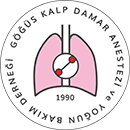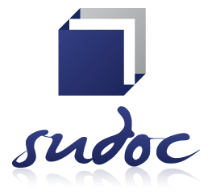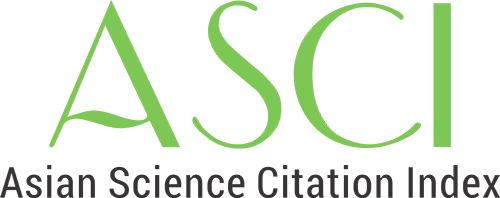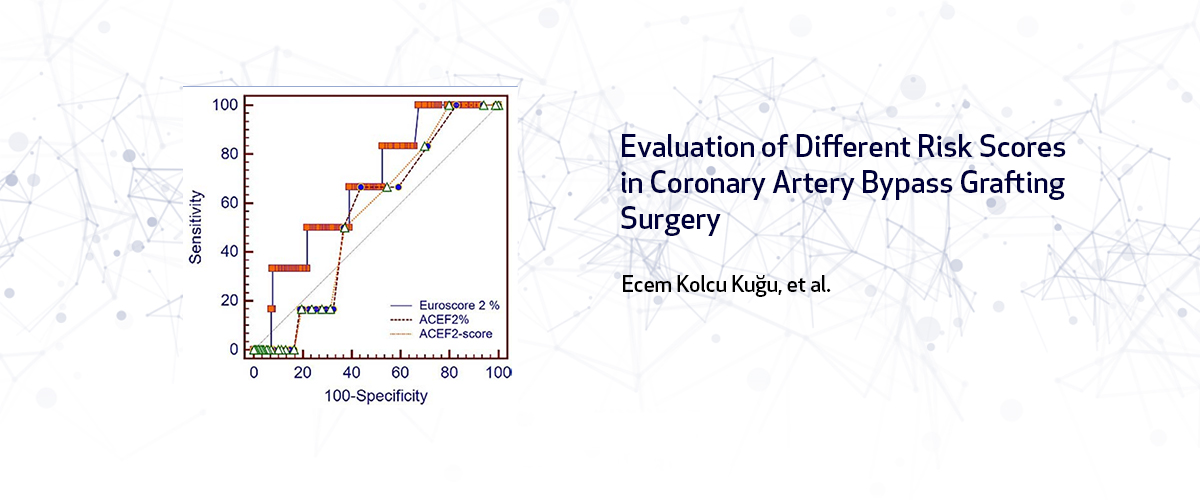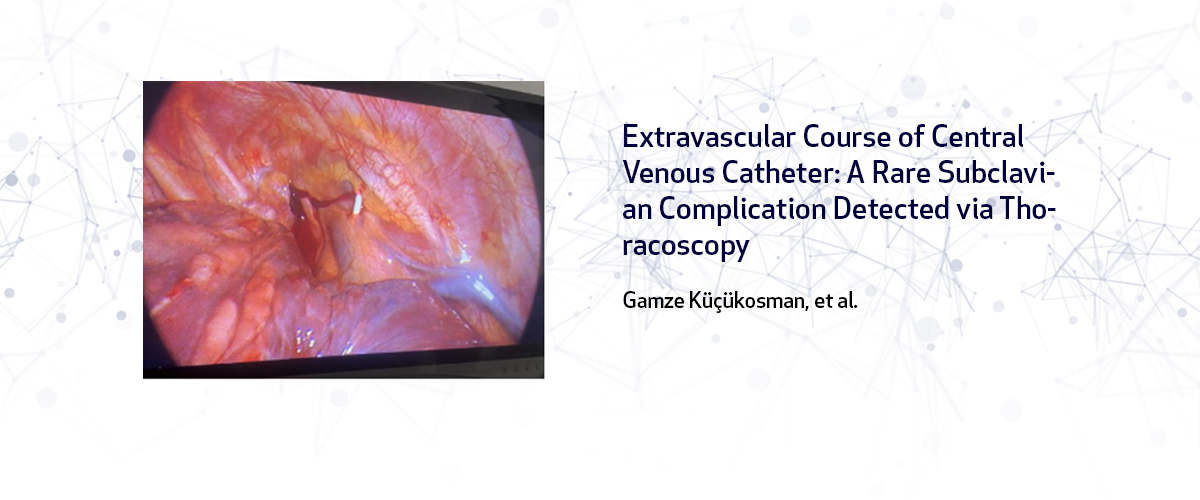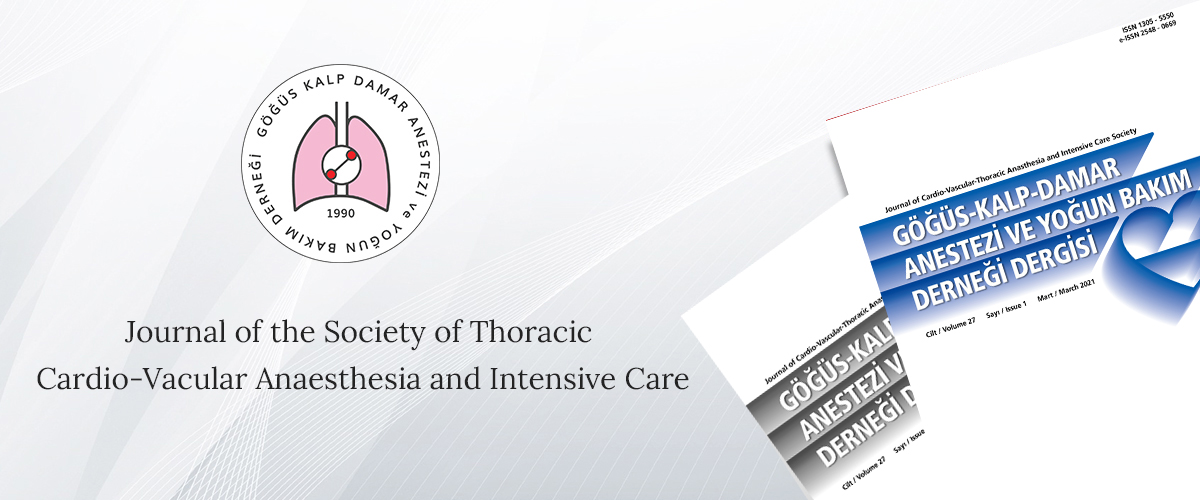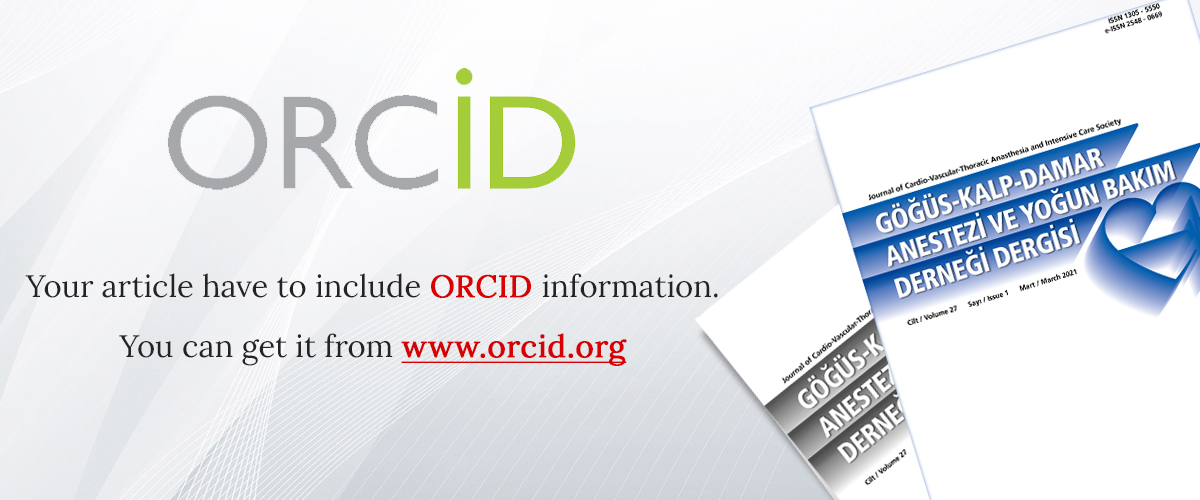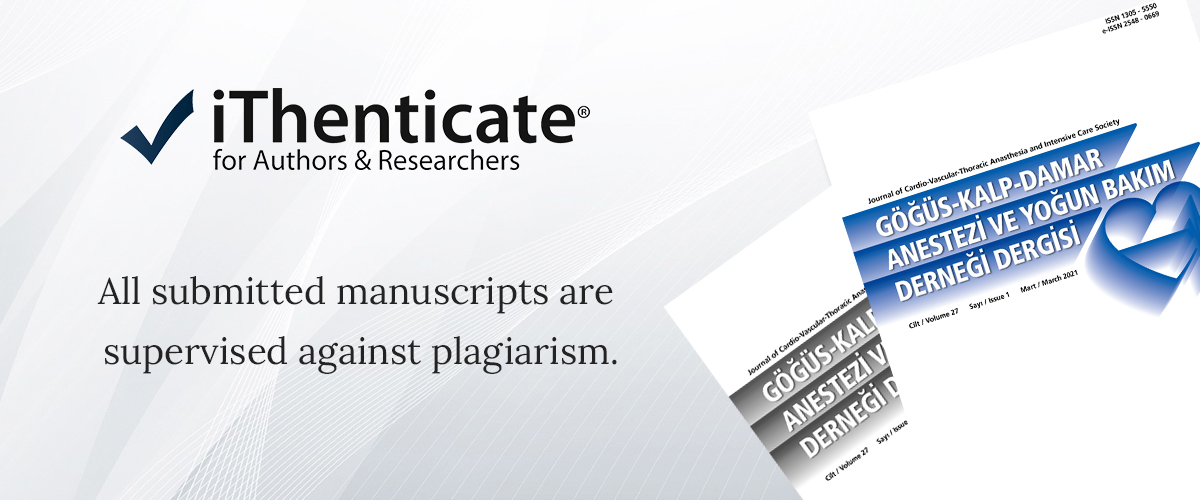

Manuscript Preparation
Manuscripts should preferably be written using the Microsoft Word program. The manuscripts should be typed in 12 point Times New Roman characters. Manuscripts should be written double- spaced on one side of the A4 (21x29.7 cm) white paper and throughout the entire manuscript (including headings, abstracts in Turkish and English, main text, references, tables and subtitles) and justified leaving 3-cm margin from both sides. They should be written in accordance with word processor's page layout settings.
Journal Agent Online Article Collection and Evaluation System is being uploaded online, Article and Abstract Information, Information about Institute, Author Information, Responsible Author Information, Article Title, Article Turkish and English Summaries of the Article, Turkish and English Key Words, NoteEdit, File Upload (Full Text - References Table(s) - Pictures - Graphics Notes to the Editor ) are recorded separately step by step in the system.
The authors are kindly requested to submit their ORCID numbers obtained the website from www.orcid.org and indicate them in the relevant area at this stage. Abstract and full text should not containinformation about the individuals and institutions participating in the study.
The files must be loaded in the following order.
- The electronic article file (Full Text) should be named with the title of the article in capital letters. They should only include "Title (Turkish-English) - Short Title (Turkish-English)", "Introduction", "Materials and Methods", "Results", "Discussion", "Acknowledgement (if) - Conflict of Interest". Each of the sections should be presented on separate pages. The titles of the text sections should appear at the left of the page with capital letters. All pages should be numbered sequentially from the bottom right corner.
- The file “References” should be recorded separately
- Tables should be prepared and written double-spaced on a separate sheet, and the number and title of each table must be written on top of the table. If abbreviations are given in the table, these abbreviations should be written in alphabetical order as subheadigs. . When previously printed or electronically published tables are used, written permission must be obtained from both the author and the publisher, and it must be sent by fax or mail to the editor of the journal.
- Figures, graphics, illustrations, photos and legends should be written double-spaced on a separate sheet. If the abbreviations are given in figures, graphics and illustrations, the expansions of these abbreviations should be written under the subtitle and in alphabetical order. When previously printed or electronically published figures, graphics and images are used, written permission must be obtained from both the author and the publisher, and this must be sent by fax or mail to the editor of the journal.
- Copyright transfer form
Authors must declare that all or part of the material in the manuscript has not been published and is not currently being evaluated elsewhere for publication. Each author must declare that he/she participated in the investigation enough to share the responsibility of its content.
This participation may involve the following issues:
- Creation of concepts and designs of experiments,
- Collection, analysis or expression of the data;
- The preparation of the draft of the mauscript or the review of the scientific content
- Approval of the final format of the manuscript ready for publication
- Ethics committee approval letter
- Original articles and review articles should not exceed 10, case reports 4, letters to editors 1 page (excluding references, tables and graphics).
In the manuscript, the sections and contents of the manuscript should be presented as follows.
Title: A short title should be used whenever possible. The title of the research, and review articles should not exceed 95 characters (each letter, space, and punctuation marks are considered as one character), in case of case reports, letters and presentations of surgical techniques it should not contain more than 80 characters. Abbreviations should not be used in the title. The title should be written in Turkish and English. A short title should be added as a subtitle which should not exceed 40 characters.
Funds and organizations supporting the research should be mentioned here, If the study is planned to be presented in any congress or if it has been presented before, the name, place, and date (day-month-year) of the congress should be written
The abstracts should not exceed 250 words in the research papers Headings should not be used in summaries (the English translation of the title should be written on the title page). Abstract in Turkish should consist of four subheadings as While abstract in English should include subheadings of Aim, Material and Method, Results, and Conclusion) In case reports and review articles donot contain these sections, and abstracts should not exceed 100 words. English title, and abstract should be. English title and abstract should be word by word translation of the Turksih abstract. Letters to editor, and Editorials do not require abstracts.
Use of abbreviations should be avoided as much as possible in summaries. If absolutely required, abbreviation should be used after its definition is provided in parenthesis at the first mention of the term. Reference should not be used in the abstract.
Key words: In accordance with "Index Medicus Medical Subject Headings (MeSH)" there should be no more than five key words under the summary written both in Turkish and English. Available terms can be used if there is no appropriate term for the "Index Medicus" medical subject headings for the newly entered terms
Introduction: The general conditions of the study settings, the structure and significance of the problem, the specific objective of the study or research tested in the study or observation should be clearly indicated. The primary and secondary objectives of the work should be clearly stated and the predefined subgroup analyzes should be transferred. Only references related to the topic should be used and the data or results of the presented work should not be included in these references.
Material and Method: The informed consent of the patient and the approval of the ethics committee should be acknowledged. A statement must be added that the informed consent was obtained from each participant in clinical trials. It should be noted in experimental studies that all animals were subjected to a humane treatment in accordance with the Guide for the Care and Use of Laboratory Animals (www.nap.edu/catalog/5140.html).
Definition of optimal working conditions, exclusion criteria and referenced population; the participants in the observational or experimental study must be clearly indicated. Since the relevance of the variables such as age and gender for the purpose of the research is not always obvious, the authors should explain the purpose of using these variables in a research article. The main principles that determine how and why the study is performed using such a method should be clear. References should be shown for established methods, brief descriptions should be given for new methods
The methods, tools (manufacturer’s name and address are written in parentheses) and the operations performed should be described in detail to the extent of interpretation of the results. The initials of the drug names should be in lower case, the pharmacological names of the drugs should be used and at their first mention in the text they should be written in brackets in the following order"Generic name, trade name, and Manufacturing firm ". Example: "midazolam (Dormicum, Roche)". The terms should be written in their explicit forms at their first mention in the text, and then their abbreviations ( if any) should be enclosed in parentheses. Frequently used abbreviations should be used as accustomed (iv, im, po and sc). Units must be used in compliance with the International system of units (SIU (Le Système international d'unités),Examples: mg / kg, mL / kg, mL / kg / min, mL / kg
Statistical methods should be provided in sufficient detail so that the readers can reach the original data and evaluate the reported results. Findings should be measured as much as possible and the appropriate margin of error and uncertainty (such as confidence intervals) should be indicated. It is important to avoid relying only on the p-values of statistical hypothesis measures that are insufficient to convey important information about the dimensions of the effects. P values must be given explicitly. Statistical terms, abbreviations and symbols should be defined. In the last paragraph of this section, statistical analyses used, and the values given by the (±) sign after the arithmetic mean or proportion should be indicated.
Results: The findings, tables and visual material obtained in the study should be written in the order of a certain logic so that the most important ones will take precedence in the text. Graphics, tables, illustrations, and figures should be numbered according to the order of their mention in the text, and should be indicated in parentheses in the text. Data contained in the tables and visual materials should not be repeated in the text. Only important observations should be emphasized or summarized. Tables and figures are placed collectively after the last reference at the end of the text. Only the top title of the table, and graphic or the subheading of figures, illustrations, photos are written in their appropriate places in the text
The numerical results summarized in the Results section should be given not only as derivatives (eg percentages), but with exact numerical values, and the statistical methods used to analyze them should be specified. When scientifically appropriate, data should be analyzed in terms of variables such as age and gender. Tables and pictures should be limited to those necessary to explain and support the discussion expressed in the article. As an alternative to the tables, you should use some kind of graphics on which many entries can be made, and data should not be repeated on graphics and tables. Using non-technical terms such as "random", "explicit", "links" and "example" in the statistics section should be avoided
Discussion: The results of the study are evaluated by comparing them with the international, and domestic literature. New and important aspects of the study and its outcomes should be emphasized. Data and other information presented in the Introduction and Results sections should not be repeated. In experimental studies, we should briefly summarize the main findings and then analyze explanations with possible mechanisms and compare them with other similar studies. It would be appropriate to comment on the implications of these findings for future researches and clinical practices. The objectives of the work should be correlated with the results. However, unmeasured situations and outcomes that are not adequately reinforced by the data should be avoided. The resulting decision arrived must be stated in the last paragraph of the discussion. If the article does not include appropriate economic data and analysis, no particular comment should be made on economic interests and costs. Claims on an incomplete study should be avoided, new hypotheses must be specified when they are confirmed, and their novelty should be clearly emphasized.
Acknowledgment (if any): If you also want to thank the people who can not fulfill the criteria for authorship involved in fundraising, technical assistance, data collection, supervisor of the research group, writing, or department chiefs who just provided general support, and those providing finance and material support, a brief paragraph can be written under the heading of “Acknowledgement.". Written consent must be obtained from the individuals to be mentioned in the acknowledgment section since they may make a sense of data and conclusions they contributed
Conflict of Interest: The authors are requested to declare any existing commercial association that might potentially have a conflict of interest regarding their articles. (eg employment, direct payments, holding shares, holding, consultancy, patent licensing arrangements, or granting honorarium). All financial resources supporting the study should also be declared as footnotes
Tables and Charts: Charts can be saved in a single chart file, tables can be placed in one spreadsheet file on each page. Titles, descriptions and footnotes should be placed on each sheet of paper.
The tables reflect the information in a concise and effective way. They also provide information of the desired quality and precision. The fact that the data are given in the tables rather than in the text usually makes it possible to shorten the text. The tables should not be a repetition of the information in the article
The tables should be demonstrated in brackets in the text. It should carry a short self-heading. According to their appearance in the text, each one should be given a short title, starting from the top left, and numbered sequentially by Roman numerals. There should be no lines on the background, they should be drawn on a white background.. Horizontal and vertical lines should not be used in the table . Each column is given a short or a concise title. Explanatory information should be placed in footnotes, not in headings. Abbreviations should be explained in footnotes. The explanations of the abbreviations should be in the form of subtitles under the table and in alphabetical order. The following symbols should be used in the footnotes, in the following order: *, , , §, ||, ¶, **, , . Measures of statistical variables such as standard deviation and standard mean error should be defined. Make sure that each table and graph are mentioned in the text.
There should be no frame around the graphics, no lines on its background, and the background should be white.
When using previously published or electronically published tables and graphics, written permission should be obtained from both the author and the publisher and they should be acknowledged. Permission should be faxed or mailed to the journal editor.
Pictures, Photos and Figures: Figures should be professionally drawn and photographed. Photographs and scans taken with a digital camera should be recorded at a resolution of at least 300 dpi, 1280x960 pixels, in jpg or tiff format. There should be no writing on the picture unless it is compulsory.
Each pictures and figure should be placed on separate pages in a file containing only pictures, figures, and photos . Naming and numbering should be done as subtitles on each page. They should be placed in the text, numbered in Arabic numerals according to the order of their appearance in the text, and shown in brackets in the text When symbols, arrows, or letters that point to specific sections of the figures, and photos are used, these should be explained in the subtitle. If so, the expansions of the abbreviations should be placed under the subtitle in alphabetical order.
Microscope magnification ratio and staining technique used should be explained.
When previously printed or electronically published figures, images, and photos are used, written permission must be obtained from both the author and the printing house and this must be sent by fax or mail to the editor of the journal.
When using the images of people whose face is not hidden and recognizable, written permission must be obtained from them.
References: One should be selective in the use of references, and should include references directly related to the study. Turkish sources should be also used and authors should be sensitive to this issue. Although referencing review articles direct readers to the proper essence of the medical literature, they do not always accurately reflect the original study. Therefore, readers should be provided with as much original research articles as possible. Avoid using summaries as a source.
Authors should compare references with original articles to minimize erroneous references that sometimes occur in published articles. Authors are responsible for the accuracy of refereces and their spelling.
If the authors can not specify whether they referenced a retracted publication or not, they are obliged to check that the references they cited do not belong to the retracted articles. For articles in the journals indexed on MEDLINE, ICMJE considers PubMed (http://www.pubmed.gov) as a reliable source of information on retracted articles. Authors may recognize the retracted articles in MEDLINE with the following search term in PubMed; retracted publication [pt] ( pt in square brackets stands for publication type).
Apart from collective and up-to-date review articles, encompassing reference lists unnecesarily occupy valuable space of the text. As a general rule, the number of references should be maximum 40 in research articles 15 in case reports, 80 in review articles, 80 in review articles and 5 in editorials.
Exchanges of information during personal contacts, unfinished articles, and other unpublished data should not be referenced.
References should be written double-spaced on a separate sheet of paper. References in the text, tables and figure legends are indicated by Arabic numbers. Only the references used in the table or picture subtitles must be numbered according to the order of their first appearance of the table, and figure in the text.
Journal titles should be abbreviated according to Index Medicus. Year, volume, the first and last pages are indicated for referenced journals, while for referenced books only year, first and the last pages are stated.
The following rules should be followed when references are given in the text:
- If the surname of the first author of the article to be cited is to be given, the abbreviation "et al." should be added followed by the reference number in superscript "[]", before completion of the sentence.
- If no name is to be given in a sentence, then the reference number must be given at the end of the sentence, after the period in a superscript bracket "[]".
- If different references will be stated for different expressions within a sentence, each reference must be given within a bracket "[]" before the punctuation mark at the end of the statement.
- If there are more than two consecutive sources exist, then the first and last ones should be indicated with a "-" sign between them, i.e: 1-3]; [14-18]; [8-14]
- Full surnames of the authors and the initials of their names should be written in references. If the number of authors in the reference is equal to or less than 6, then all authors should be indicated. . If the number of authors is more than 6, then the first 6 authors should be written before the abbreviation "et al." (for international publications) or "ve ark." (for national publications).
- The DOI number must be added at the end of the each reference
The format of writing the references should conform to the "Vancouver reference style". Except for the examples below, the web address should be checked in spelling.
(http://www.nlm.nih.gov/bsd/uniform_requirements.html)
Journal Articles:
References from International Journals:
Tosun Z, Akin A, Guler G, Esmaoglu A, Boyaci A. Dexmedetomidine-ketamine and propofol-ketamine combinations for anesthesia in spontaneously breathing pediatric patients undergoing cardiac catheterization. J Cardiothorac Vasc Anesth 2006;20:515-19. doi:10.1053/j.jvca.2005.07.018
For national references
Toraman F, Ustalar Özgen S, Sayın Kart J, Arıtürk C, Erkek E, Güçlü P ve ark. Koroner arter baypas cerrahisinde fentanil ve midazolamın hedef kontrollü infüzyon (hki) şeklinde kullanımının anestezi düzeyi ve ilaç tüketimi üzerine etkileri. GKDA Derg 2013;19:113-17. doi:10.5222/GKDAD.2013.113
Additional Issue:
Solca M. Acute pain management: unmet needs and new advances in pain management. Eur J Anaesthesiol 2002; 19 Suppl 25:3-10.
Kahveci FŞ, Kaya FN, Kelebek N ve ark. Perkutan trakeostomi sırasında farklı havayolu tekniklerinin kullanımı. Türk Anest Rean Cem Mecmuası 2002; Kongre ek sayısı: 80.
Book
Murray PR, Rosenthal KS, Kobayashi GS, Pfaller MA. Medical microbiology. 4th ed. St. Louis: Mosby; 2002.
Chapter in a Book
Meltzer PS, Kallioniemi A, Trent JM. Chromosome alterations in human solid tumors. In: Vogelstein B, Kinzler KW, editors. The genetic basis of human cancer. New York: McGraw-Hill; 2002. p. 93-113.
Dissertation
Gurbet A. Comparison of morphin, fentanyl, and remifentanyl with patient-controlled analgesia (PCA) following off-pump coronary artery surgery . (Dissertation). Bursa, Uludağ University, 2002.
Reference from Electronic Media:
United Kingdom Department of Health. (2001) Comprehensive Critical Care Review of adult critical care services. The web site: http://www.doh.gov.uk/compcritcare/index.html
Internet Address:
1996 NRC Guide for the Care and Use of Laboratory Animals. Available at:
http://www.nap.edu/readingroom/books/labrats/contents. html. Accessed October 20, 2003.
The text should be controlled from the “Check List” before submission. This control will speed up the evaluation process of the manuscript (see Checklist)
